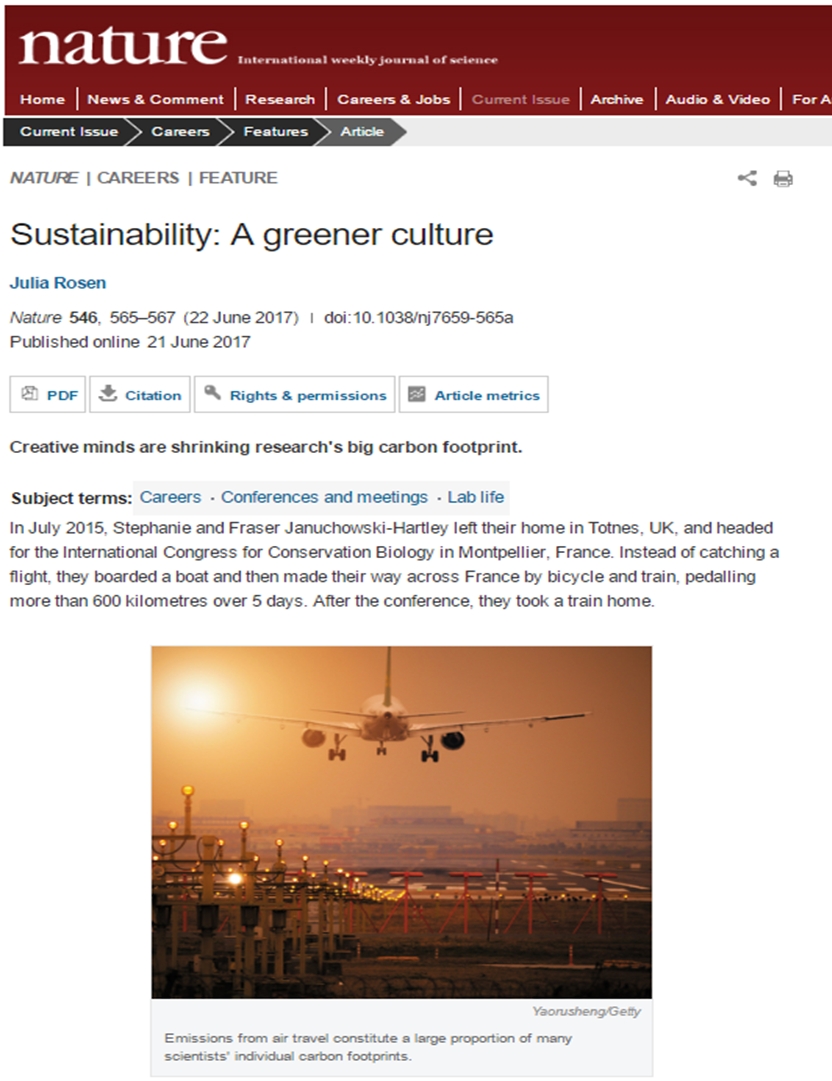by Parke Wilde
National Geographic on June 20 ran an article, authored by a “points expert” from an affiliate marketing site, making misleading claims for “greener” air travel, with funding from the aviation and defense technology company United Technologies.
The article by Eric Rosen, with the headline “Air travel could get greener even as flights double,” was not marked as advertising, and yet the article seems unlikely to meet the magazine’s usual editorial standards. National Geographic did not respond to my questions about the article.
Misleading claims
Although the headline says air travel could “get greener,” the critical section on environmental impact addresses a much less ambitious goal: “how to prevent a doubling in air traffic from doubling the environmental impact of air travel in the coming decades.”
This section says a new voluntary United Nations program on aviation climate impacts, called “CORSIA,” would have “emissions capped at 2020 levels,” which is quite misleading. Under CORSIA, aviation emissions would continue to climb rapidly, but “net” emissions would be capped through the purchase of offsets, using other industry sectors to compensate for the growth in aviation emissions. This offset scheme is thought by experts to be unlikely to achieve its goals, and, even in the most optimistic scenario, the word “net” in “net emissions” is required for honest reporting. Not even the strongest supporters of CORSIA claim that it caps aviation emissions themselves at 2020 levels.
The article makes exaggerated claims about aviation technologies, for which the only source cited is Sean Newsum, the “director of environmental strategy” for Boeing, a major airplane manufacturer. For example, Newsum makes an implausible claim for aviation biofuels: “Biofuels represent huge potential reductions of between 50 to 80 percent of the lifetime carbon emission of both existing and future aircraft.” A good source for more credible information about biofuels and other technology myths is Peeters et al. (2016).
An accompanying quiz on the website is titled, “How green is air travel?” One of the questions asks, “Which of these is NOT a way a reduction in emissions will be achieved?” The options are: (a) Fewer passengers, (b) Improved technology, (c) Better operations, and (d) Alternative fuel.” The correct answer? You guessed it — “Fewer passengers.” The accompanying explanation says, “Air travel numbers are going up, not down. Passenger loads are expected to double over the next 20 years.” With this sleight of hand, National Geographic switches the topic from promising methods to projected trends, to make demand side changes look like the wrong answer to a question about reducing aviation emissions.
Authored by Eric Rosen, a “points expert”
The National Geographic article’s author, Eric Rosen (@EricRosenLA), is a travel writer and self-described “points expert.” I could find no prior reporting on climate change, the environment, or indeed any other science topics.
This week, in typical fare, he writes for Bravo on “OMG, LOL: 35 funny three-letter airport codes that will make you giggle, BRO!” You can imagine his chuckles at Fukuoka, Japan, and Gaya, India.
Rosen is identified as managing editor and writer for “The Points Guy,” an affiliate marketing site. The “advertiser disclosure” explains how it works. The site takes advertising from credit card companies and other businesses and writes articles on frequent flyer points programs and other air travel topics. The articles may favorably discuss the advertisers’ products. The site’s slogan is, “maximize your travel.”
National Geographic sponsorship by United Technologies
The footer to the National Geographic article says, “This article is part of our Urban Expeditions series, an initiative made possible by a grant from United Technologies to the National Geographic Society.” United Technologies is a Fortune 500 commercial aerospace and defense company, owner of the Pratt and Whitney aviation engine manufacturer and many other subsidiaries.
The article is not marked as advertising. From other pages and search engines on the National Geographic site, links to the article are not identified as having been sponsored.
Questions for National Geographic
It is difficult to believe this article meets National Geographic editorial standards for an article touching on important scientific issues such as climate change. From the headline, it is not possible to pass this article off as a harmless piece of travel “fluff.” And, yet, the identification of sponsorship is not sufficiently thorough to meet journalistic standards if National Geographic wants to say this article was intended to be seen as “advertising,” with no implication that it met usual editorial standards.
I wrote the editor and the press office on July 7 seeking comment. I offered to share their point of view on all the issues in this post, including the United Technologies sponsorship, the Boeing sources, the experience of the author, and the substantitive doubts about the coverage of aviation emissions technologies. National Geographic did not respond.
National Geographic magazine was purchased some years ago by the Murdoch family’s Fox media companies (as a 2015 article in the Guardian discusses). Rupert Murdoch is a leading global media magnate, supporter of conservative political causes, and well-known climate change skeptic. At some times in recent years, the National Geographic organization more broadly has done some vigorous reporting on climate change, including the “Years of Living Dangerously” documentary on National Geographic Channel. Yet, in my own view, this Eric Rosen article on greener aviation appears akin to greenwashing and aviation industry propaganda, not within the bounds of real journalism.


